
Iron ore is a combination of minerals from which metallic iron can be extracted economically.
Key facts
- Canada is the world’s eighth-largest producer of iron ore.
- Canada’s iron ore is mined in Quebec, Newfoundland and Labrador, and Nunavut.
- Canada has some of the highest-grade iron ore in the world that is suitable for making green steel using electric arc furnaces.
Learn more about iron ore
 Uses
Uses
Approximately 98% of iron ore is used to make steel. The remaining 2% serves various other applications, including powdered iron for certain types of steel, auto parts and catalysts; radioactive iron for medicine; and iron blue in paints, inks, cosmetics, and plastics.
Iron ore, global uses, 2023
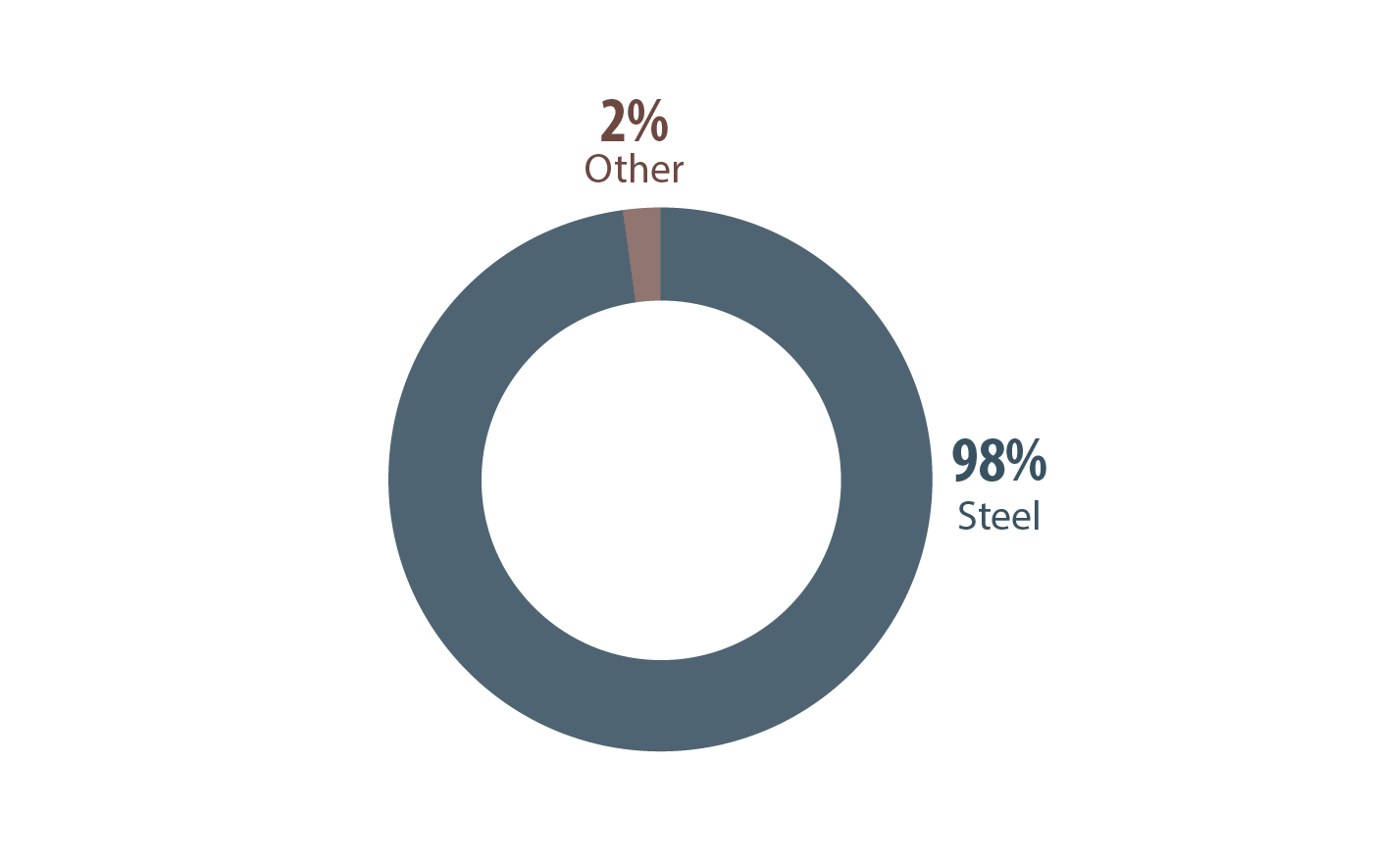
Other: powdered iron, iron 59, iron blue, black iron oxide
Text version
This pie chart illustrates the primary global uses of iron ore, with 98% dedicated to steel production. The remaining 2% covers various other applications, including powdered iron, radioactive iron (iron 59), iron blue and black iron oxide.
 Production
Production
In 2023, Canadian mine production of iron ore in concentrate and pellets reached 59.4 million tonnes, marking a 9% decline from the previous year.
Canada's estimated crude steel production for 2023 remained steady at 12 million tonnes, showing no significant change from 2022.
Canadian mine production of iron ore, 2014–2023 (p)
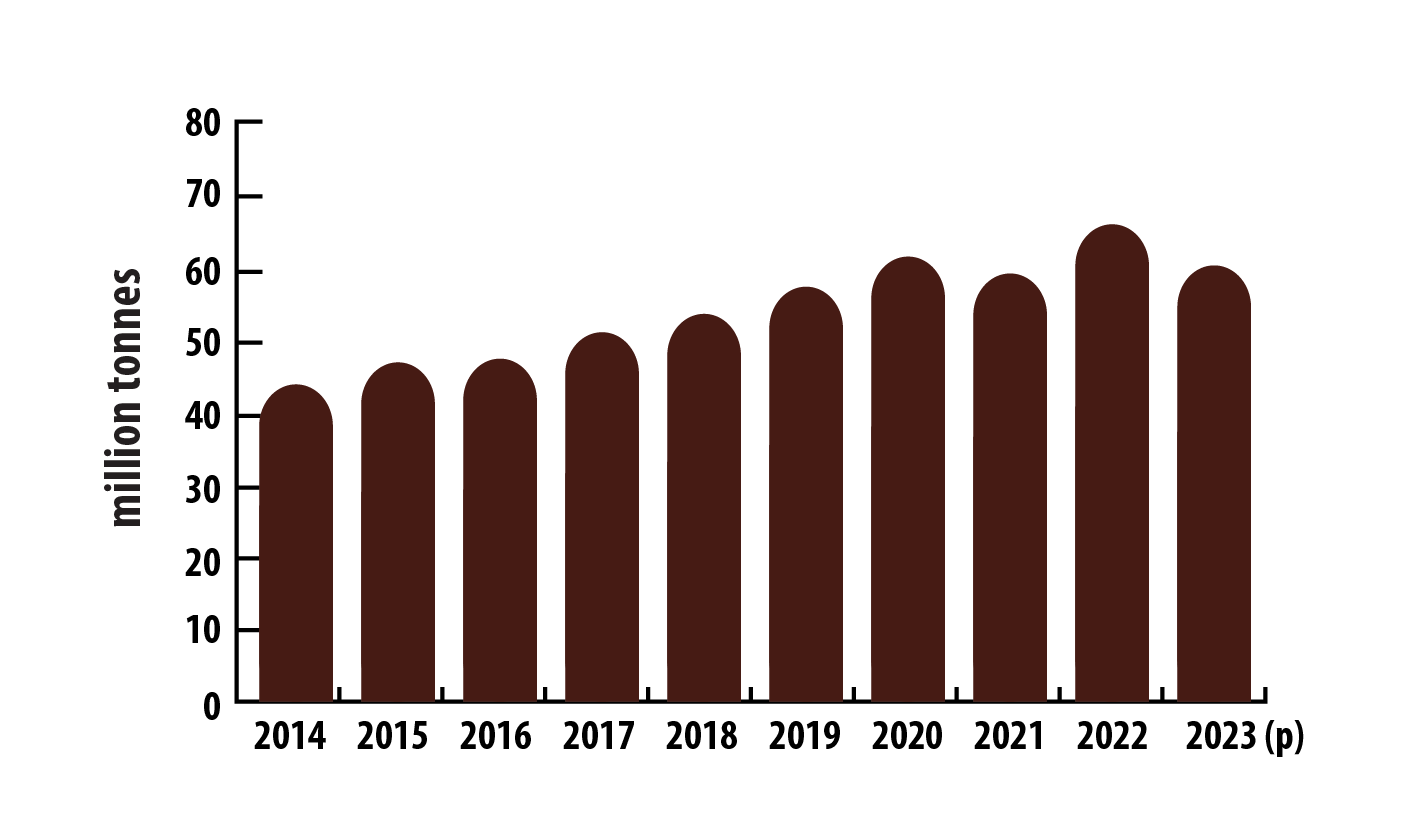
Text version
This bar graph illustrates Canada's annual mine production of iron ore from 2014 to 2023. The lowest production yield in that decade was in 2014, at 43.2 million tonnes. Output rose steadily, peaking at 60.6 million tonnes in 2020. After a slight decline to 58.3 million tonnes in 2021, production increased to 65.0 million tonnes in 2022 before decreasing to 59.4 million tonnes in 2023.
Most of Canada's iron ore comes from the Labrador Trough region bordering Quebec and Newfoundland and Labrador. A substantial amount is also produced by the Mary River Mine in Nunavut.
Canadian mine production (shipments) of iron ore, by province and territory, 2023 (p)
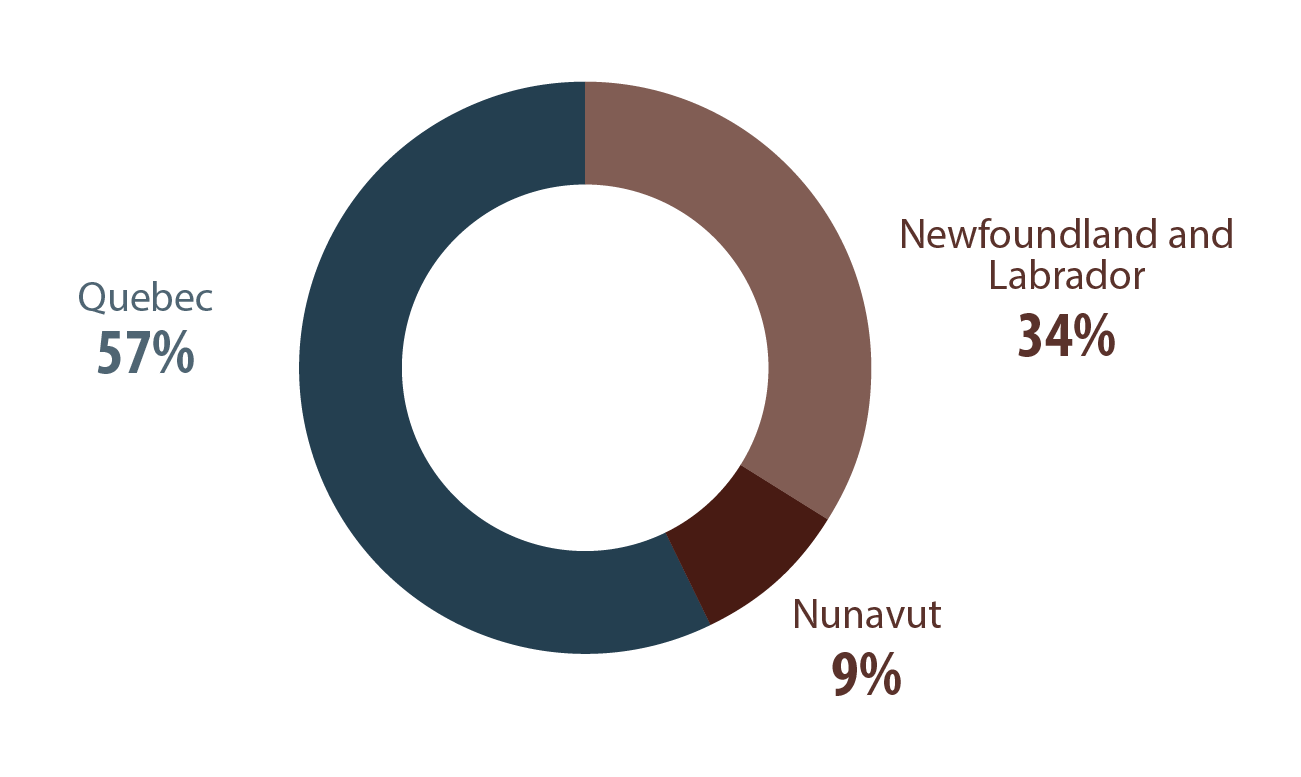
Text version
This graph illustrates Canada’s iron ore production by province and territory in 2023. Quebec led with 33.6 million tonnes, representing 57% of the total production. Newfoundland and Labrador followed with 20.2 million tonnes, accounting for 34%, while Nunavut contributed 5.6 million tonnes, making up 9% of the national production.
Consult a map of producing Canadian mines
 International context
International context
In 2023, global production of iron ore reached an estimated 2,489 million tonnes, a 5% decline from 2022. The top four producers collectively contributed 78% of the world's iron ore. Australia was the largest producer, accounting for nearly 39% of the total. Canada ranked as the eighth-largest iron ore producer globally and sixth in terms of reserves.
| Ranking | Country | Million tonnes | Percentage of total |
|---|---|---|---|
| 1 | Australia | 960 | 38.6% |
| 2 | Brazil | 440 | 17.7% |
| 3 | China | 280 | 11.2% |
| 4 | India | 270 | 10.8% |
| 5 | Russia | 88 | 3.5% |
| 6 | Iran | 77 | 3.1% |
| 7 | South Africa | 61 | 2.5% |
| 8 | Canada | 59 | 2.4% |
| 9 | Kazakhstan | 53 | 2.1% |
| 10 | United States | 44 | 1.8% |
| - | Other countries | 157 | 6.3% |
| Total | 2,489 | 100.0% |
World mine production of iron ore, 2014–2023 (p)
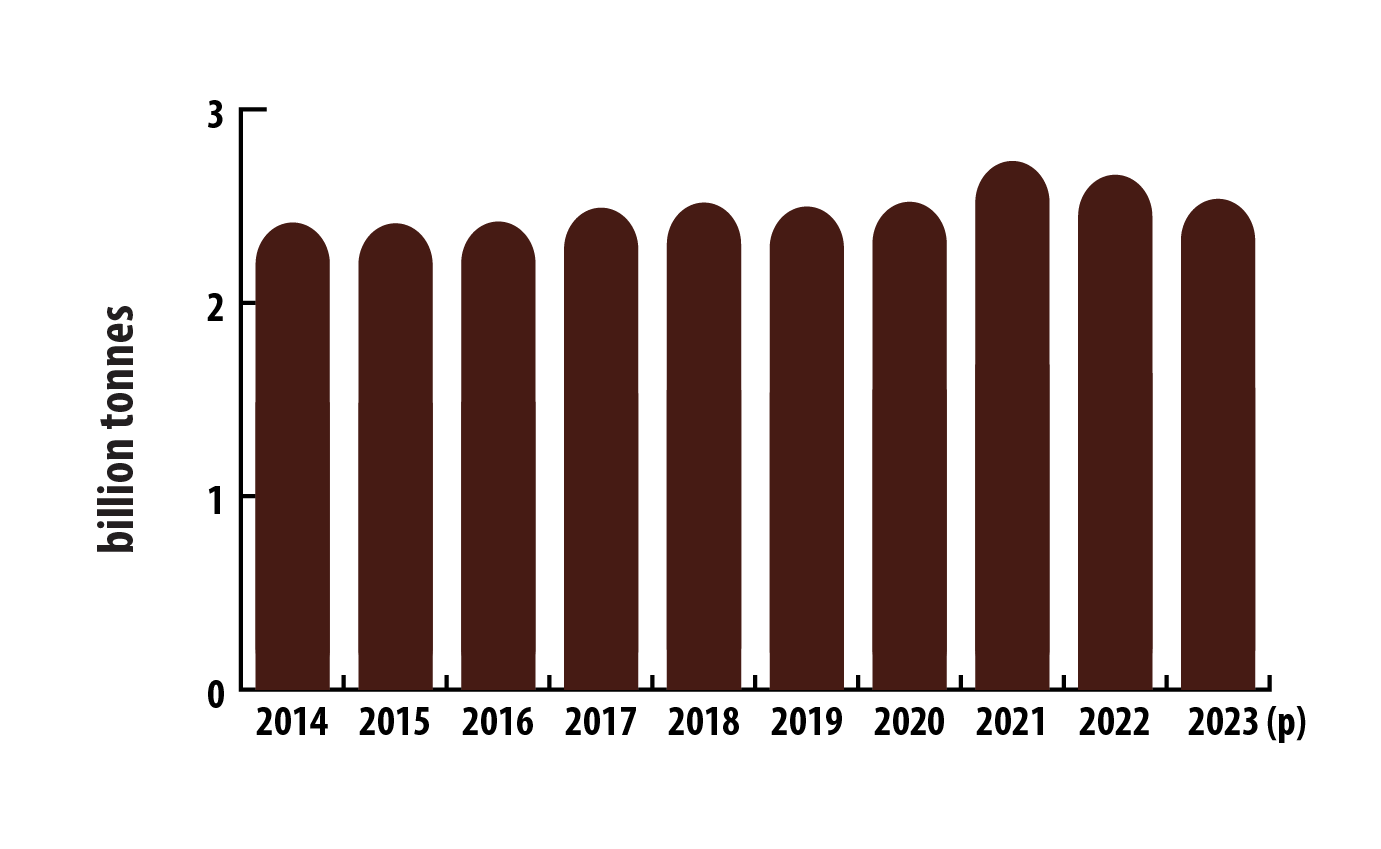
Text version
This bar graph illustrates the annual global mine production of iron ore from 2014 to 2023. In 2014, production was 2,369 million tonnes, but decreased slightly to 2,365 million tonnes in 2015. Subsequently, production increased steadily to a decade high of 2,681 million tonnes in 2021. However, production decreased to 2,611 million tonnes in 2022 and to 2,489 million tonnes in 2023.
World reserves
| Ranking | Country | Million tonnes | Percentage of total |
|---|---|---|---|
| 1 | Australia | 58,000 | 30.5% |
| 2 | Brazil | 34,000 | 17.9% |
| 3 | Russia | 29,000 | 15.3% |
| 4 | China | 20,000 | 10.5% |
| 5 | Ukraine | 6,500 | 3.4% |
| 6 | Canada | 6,000 | 3.2% |
| 7 | India | 5,500 | 2.9% |
| 8 | Iran | 3,300 | 1.7% |
| 9 | United States | 3,100 | 1.6% |
| - | Other countries | 25,542 | 13.4% |
| Total | 190,000 | 100.0% |
 Trade
Trade
Exports
In 2023, Canada exported 58.2 million tonnes of iron ore, worth $8.9 billion, compared to 55.1 million tonnes valued at $8.7 billion in 2022. The increase in volume, coupled with a lower export value, reflects lower prices in 2023. Of the total export volume, iron ore pellets comprised 28%, while the remaining 72% were other concentrates (non-agglomerated).
Imports
In 2023, Canada imported 8.2 million tonnes of iron ore, valued at $1.1 billion, up from 7.8 million tonnes valued at $938 million in 2022. Of the total imported volume, 97% were pellets, with the remainder consisting of other concentrates. Nearly all pellets came from the United States, while concentrates were imported primarily from Australia (42%), the United States (35%) and Sweden (23%). These non-agglomerated concentrates are used in producing blast furnace pellets and metallization pellets.
Additionally, Canada was a net importer of semi-fabricated steel products in 2023, with imports of 8.4 million tonnes and exports of 6.6 million tonnes.
 Prices
Prices
Iron ore prices have been volatile over the past decade, peaking at US$214 per tonne in June 2021 and falling to a low of US$41 per tonne in December 2015.
In 2023, prices started at US$128 per tonne, fluctuated throughout the year, and reached a peak of US$137 per tonne by December. These price variations reflect changing demand trends from steel manufacturers, driven primarily by activity in China.
Iron ore prices, monthly average, 2014–2023
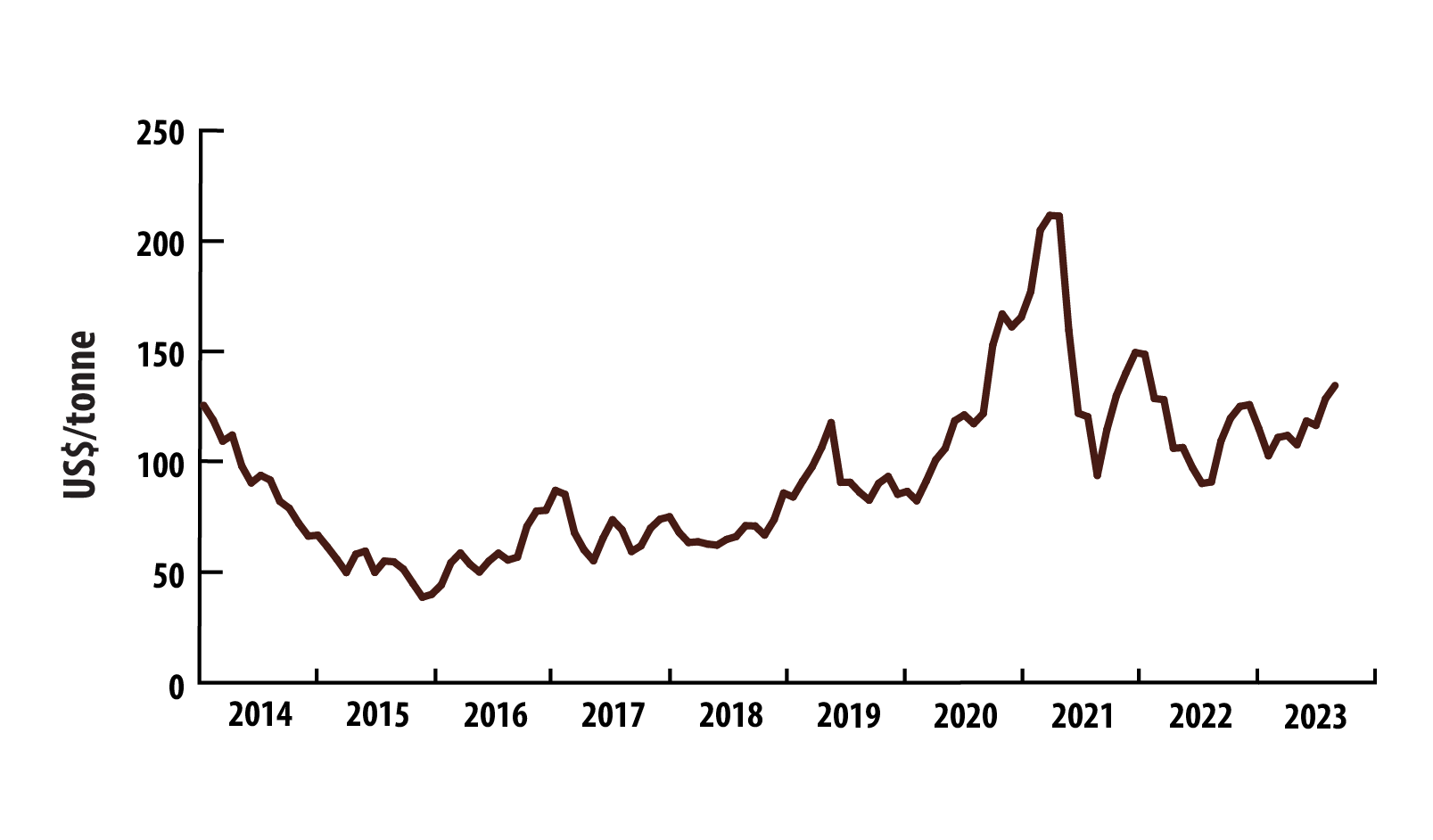
Text version
This line graph shows average monthly iron ore prices in US dollars per tonne from 2014 to 2023.
In January 2014, iron ore prices peaked at US$128 per tonne but fell sharply to a decade low of US$41 per tonne by December 2015. A moderate recovery in 2016 and 2017 raised prices to US$89 per tonne in February 2017 before a decline to US$72 per tonne by year’s end.
In 2019, prices rose from US$76 per tonne in January to US$120 per tonne in July, then stabilized around US$90 per tonne, which held through to May 2020. The next changes were a decade high of US$214 per tonne in June 2021 followed by a drop to US$96 per tonne by November 2021. In 2018, prices averaged US$70 per tonne.
Prices rebounded to US$152 per tonne in March 2022 but fell to US$93 per tonne by October, closing the year at US$112 per tonne. In 2023, prices climbed to US$128 per tonne in March and rose again in November and December, reaching an annual high of US$137.
 Recycling
Recycling
Steel is entirely recyclable and can be reprocessed indefinitely without compromising quality. Recycling steel offers significant savings in both energy and raw materials. Each tonne of recycled scrap steel conserves over 1,400 kilograms of iron ore, 740 kilograms of coking coal, and 120 kilograms of limestone.
Steel production using electric arc furnaces, which rely entirely on scrap metal, drastically reduces energy consumption compared to traditional methods that use ore. Since 1960, the energy required to produce a tonne of steel has decreased by 40%.
In 2023, Canada exported 4.8 million tonnes of steel scrap, valued at $2.8 billion, compared to 4.6 million tonnes worth $3.1 billion in 2022. Imports of steel scrap totaled 0.8 million tonnes, valued at $370 million, down from 1.1 million tonnes worth $377 million in 2022.
Notes and sources
(p) preliminary
Totals may be different because of rounding.
All dollars are Canadian unless otherwise indicated.
Uses
- Iron ore, global uses, 2023
- Iron – Minerals Education Coalition
Production
- Canadian estimated crude steel production
- World Steel Association
- Canadian mine production of iron ore, 2014–2023 (p)
- Natural Resources Canada; Statistics Canada
- Canadian mine production (shipments) of iron ore, by province and territory, 2023 (p)
- Natural Resources Canada; Statistics Canada
- company reports
International context
- World mine production of iron ore, by country, 2023 (p)
- Natural Resources Canada; U.S. Geological Survey; Statistics Canada
- World mine production of iron ore, 2014–2023 (p)
- U.S. Geological Survey
- World reserves of crude iron ore, by country, 2023 (p)
- U.S. Geological Survey
Trade
- Natural Resources Canada; Statistics Canada
- Mineral trade includes ores, concentrates, and semi- and final-fabricated mineral products.
- Steel includes stage 3 semi-fabricated products.
Prices
- Iron ore prices, monthly average, 2014–2023
- World Bank
Recycling
- World Steel Organization, Circular Economy
- Natural Resources Canada; Statistics Canada
- Waste and scrap of steel, steel alloys and cast iron